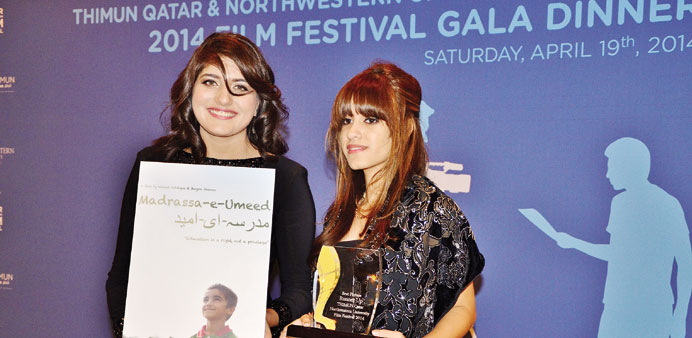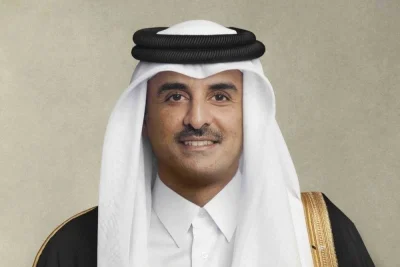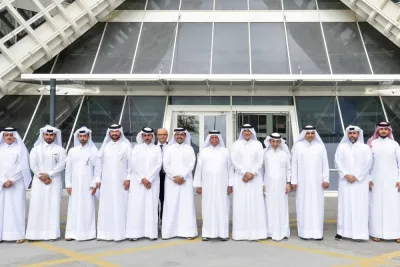PROUD: Nismah Siddique, left, and Shayna Dhanoo, right, with their trophy at the gala dinner.
Two students at Doha College point their camera to what they believe is an important story to tell, and win prize at an international film festival, writes Umer Nangiana
The power of a well-directed lens, pointed in the right direction at the right time, has long been acknowledged. Sometimes just one picture is all it takes to bring about change in hundreds of lives.
How about dozens of them put on a reel?
Camera is perhaps the best weapon to fight social injustices, human rights violations and similar menaces. Nothing beats the power of lens particularly when it comes to attracting mass attention towards a neglected segment of the social fabric.
So, if you have a camera in hand, you just need to know where and when to use it. The rest is all instinct. You can make a difference. Two young girls, the students of Media Studies at Doha College, have recently done just that.
Putting their newly-learned skills to work, Nismah Jahanzeb Siddique and Shayna Dhanoo, the two student filmmakers, recently got international recognition by winning a runner-up prize for Best Picture at THIMUN Qatar Northwestern University Film Festival 2014, with their documentary Madrassa-e-Umeed (a school of hope).
Inspired by the “Education for all” programme of a non-profit organisation, Pakistan Welfare Forum (PWF), Madrassa-e-Umeed shows one of the many ways real difference can be made. PWF is providing free education to hundreds of children and adults from underprivileged segments of the local Pakistani community, people who would not otherwise have access to institutional education.
How did they find their subject? Nismah, talking to Community with Shayna sitting beside her, said they always felt strongly about “education being people’s right, not a privilege. They (the PWF) were promoting for all children to have education and we thought that is good and we should really promote it.”
This message also forms the core of their movie. The two girls were excited on their efforts being acknowledged.
“In Qatar you think that everyone should have access to education and then you find out that there was this whole community that did not have access to education and that the PWF was [helping them out],” she said.
Armed with Digital SLRs, the two girls shot the less than 10-minute-long film in two days. From preparing the storyboard and writing the script to editing the movie, it was all their own work. They were the directors. However, their peers, the schools and friends did chip in with some assistance.
Luke Davies, their teacher, helped them improve the script while one of their class fellows, Oliver Morris, composed the film’s soundtrack on his guitar for them. The school provided them with the required logistical support.
The film’s poster, with the picture of a boy looking skywards, gives an indication about the two filmmakers’ abilities even before one gets down to watching the movie. Cinematography is excellent and the pictures, captured from all the right angles, are aptly put together. Nismah gives the voiceover.
Who is best with the camera? “I think Shayna, for sure,” Nismah replied quickly. Both chuckled.
Shayna added, “I think we both are good at it. She took mostly the moving shots and I took the close up shots. We both took turns and then we collaborated.”
It was a brilliant effort to keep the film alive and interesting from start to the end, particularly when it did not include interviews or sound bites.
“We wanted to take interviews as they help the audience to relate to the characters but then those people did not want to be singled out, specified or identified, so we said okay fine we would go without it,” said Nismah.
The movie starts with showing those privileged to have education at best institutions and how one in five children does not have access to education, before the camera panes to the subject children in their small three-room school behind Pakistan Education Centre. Here they are getting free education.
Some students did talk to them in Urdu but here again these could not be put on screen lest the parents take offense. One hindrance the filmmakers faced was a language barrier as most of the children spoke their native Balochi language.
“But then they would come to us and show how they were learning A, B, C and doing drawings and colouring and that is how we interacted with them,” the two girls added.
When their names were announced as runners-up at the festival, the two girls said they were pleasantly surprised. “We were really proud because when they called our names we were in shock, we were not expecting this,” said Shayna.
The student filmmakers were content with the results. The girl who won the first prize, they said, truly deserved it. “Her cinematography was brilliant and the story was also very good,” Nismah added.
Fans of documentary films, both Nismah and Shayna said they would definitely grab any opportunity to make films whenever they find an equally compelling subject. However, they were planning to pursue two different career paths.
Nismah is planning to do fashion designing and her friend Shayna is more interested in environmental sciences and geography. Even so, Nismah believes “this for me was a good experience. If another opportunity comes, we will take it. We cannot let it pass. It was so much fun. If something comes that is equally good as this, I would definitely go for it.”
Shayna agreed with her. “Yes, it can continue as a hobby. It is really good but I love environmental sciences as well.”
THIMUN Qatar Northwestern Film Festival is designed to encourage students to develop their filmmaking skills and raise awareness about important global issues.
The film festival offers educational support material, workshops, and a gala awards evening to celebrate excellence. Students who are nominated for a prize at the festival receive a complimentary plane ticket and accommodations.



